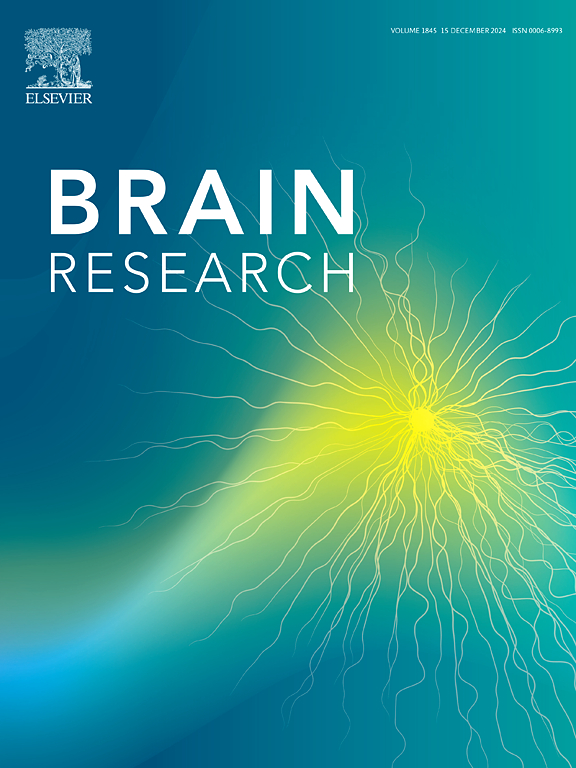Nuclear factor erythroid 2-related factor improves depression and cognitive dysfunction in rats with ischemic stroke by mediating wolfram syndrome 1
IF 2.7
4区 医学
Q3 NEUROSCIENCES
引用次数: 0
Abstract
Objective
This research aims to investigate the molecular mechanism of nuclear factor erythroid 2-related factor (Nrf2) in improving post-stroke depression and cognitive impairment (PSDCI) by mediating wolfram syndrome 1 (Wfs1).
Methods
PSDCI rat model was established through middle cerebral artery occlusion (MCAO) and chronic unpredictable mild stress (CUMS). Dimethyl fumarate (DMF) was utilized as an Nrf2 activator, while Wfs1 knockdown lentiviral plasmid was injected into rats for functional investigations. Cognitive function- and depression-relevant parameters were assessed using Morris water maze, forced swimming, sucrose preference, modified neurological severity score (mNSS) tests. The infarct size, pathological changes, and neuronal damage were also evaluated. Additionally, oxidative stress- and inflammatory response-associated proteins were detected by enzyme-linked immunosorbent assay. The binding relation between Nrf2 and the Wfs1 promoter region was analyzed and verified by dual-luciferase and chromatin immunoprecipitation assays.
Results
PSDCI rats had reduced Nrf2 and Wfs1 expression in the hippocampal tissue and inhibited nuclear translocation of Nrf2, showing aggravated oxidative stress and inflammatory responses as well as cognitive dysfunction- and depressive-like symptoms. However, these symptoms in PSDCI rats can be alleviated in response to Nrf2 activation. Furthermore, Nrf2 activation increased the enrichment level of Nrf2 in the Wfs1 promoter region, promoting the transcriptional expression of Wfs1. Wfs1 knockdown partly reversed the effect of Nrf2 activation on the neuronal damage, cognitive dysfunction- and depressive-like symptoms of PSDCI rats.
Conclusion
Nrf2 activation can promote Wfs1 expression to reduce neuroinflammation and oxidative stress responses, ultimately alleviating PSDCI in rats.

核因子红系2相关因子介导wolfram综合征改善缺血性脑卒中大鼠抑郁和认知功能障碍1。
目的:本研究旨在探讨核因子红系2相关因子(Nrf2)通过介导wolfram综合征1 (Wfs1)改善脑卒中后抑郁和认知障碍(PSDCI)的分子机制。方法:通过大脑中动脉闭塞(MCAO)和慢性不可预测轻度应激(CUMS)建立PSDCI大鼠模型。利用富马酸二甲酯(DMF)作为Nrf2激活剂,并将Wfs1敲低慢病毒质粒注射到大鼠体内进行功能研究。采用Morris水迷宫、强迫游泳、蔗糖偏好、改良神经严重程度评分(mNSS)测试评估认知功能和抑郁相关参数。观察梗死面积、病理改变及神经元损伤情况。此外,通过酶联免疫吸附法检测氧化应激和炎症反应相关蛋白。通过双荧光素酶和染色质免疫沉淀法分析并验证了Nrf2与Wfs1启动子区的结合关系。结果:PSDCI大鼠海马组织Nrf2和Wfs1表达降低,Nrf2核易位抑制,氧化应激和炎症反应加重,出现认知功能障碍和抑郁样症状。然而,Nrf2激活后,PSDCI大鼠的这些症状可以得到缓解。此外,Nrf2激活增加了Wfs1启动子区域Nrf2的富集水平,促进了Wfs1的转录表达。Wfs1敲低部分逆转了Nrf2激活对PSDCI大鼠神经元损伤、认知功能障碍和抑郁样症状的影响。结论:Nrf2激活可促进Wfs1表达,减轻神经炎症和氧化应激反应,最终减轻大鼠PSDCI。
本文章由计算机程序翻译,如有差异,请以英文原文为准。
求助全文
约1分钟内获得全文
求助全文
来源期刊

Brain Research
医学-神经科学
CiteScore
5.90
自引率
3.40%
发文量
268
审稿时长
47 days
期刊介绍:
An international multidisciplinary journal devoted to fundamental research in the brain sciences.
Brain Research publishes papers reporting interdisciplinary investigations of nervous system structure and function that are of general interest to the international community of neuroscientists. As is evident from the journals name, its scope is broad, ranging from cellular and molecular studies through systems neuroscience, cognition and disease. Invited reviews are also published; suggestions for and inquiries about potential reviews are welcomed.
With the appearance of the final issue of the 2011 subscription, Vol. 67/1-2 (24 June 2011), Brain Research Reviews has ceased publication as a distinct journal separate from Brain Research. Review articles accepted for Brain Research are now published in that journal.
 求助内容:
求助内容: 应助结果提醒方式:
应助结果提醒方式:


